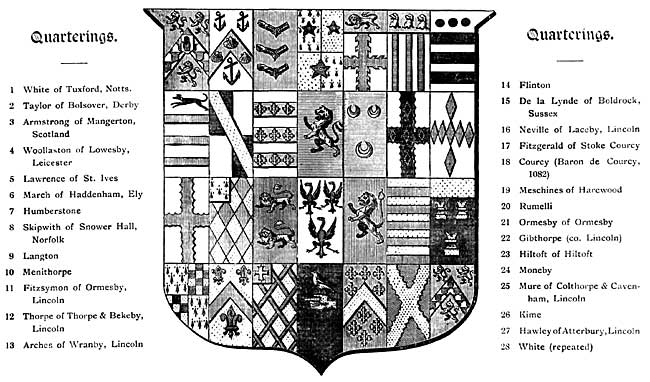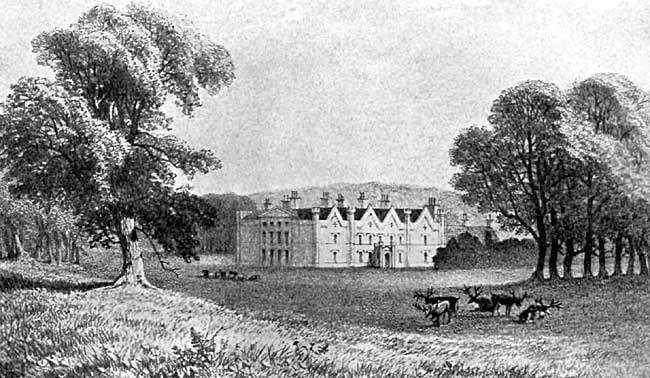Some account of the family of White
of Tuxford and Wallingwells.
Miss M H TOWRY WHITE

Shield of the White Family.
THE Whites of Tuxford, Notts., came originally from Suffolk, being descendants of Bartholomew le Wite, of Stoke Nayland, and Alice, his wife, living in 1272. Their armorial bearings were existent in the church of Stoke Nayland in 1801, and may be so still. From this parent stem diverged four branches. One settled in Norfolk, ending in 1600, a second were progenitors of White, Bishop of Ely, a third, the Whites of Essex, and a fourth, those of Collingham and Tuxford, Notts.
Sir John White, Knight, great-great-great grandson of Bartholomew, was at the sieges of Harfleur and Rouen, and died about 1417.
In 1433 (12 Hen. VI.) commissioners were appointed by the Crown in different counties of England "to summon all persons of quality before them, and to tender to them an oath for the better keeping of the peace, and observing the king's laws, both in themselves, and in their retainers or dependants." The names of the commissioners, and the lists of those thus summoned, are still extant. The commissioners for Notts, were John, Archbishop of York, Humfrey, Earl of Stafford, and Richard Stanhope, one of the knights of the shire. In the Notts. list appears the name of Johannes White de Colyngham. His son, John, also of Collingham, purchased in 1545-7, of Sanchia Stanhope, wife of Thomas Babington, that part of the manors of Tuxford, of which she was heiress, through her father, Sir John Stanhope, of Rampton. John White died in 1567. Thomas, his son, married Anne or Agnes Cecil, sister of the celebrated Lord Burghley, before 1553. Frequent references to "my brother White" occur in Lord Burghley's letters, and Thomas White is also mentioned as staying at Burghley and advising Dame Jane Cecil (his wife's mother) as to the making of the inventory of her husband's property. Plate and moneys are left to Anne White in Burghley's will. Her effigy may be seen in Stamford Church, on the monumental tomb of her parents, with this inscription— "Anne, married to Thomas White of Tuxford Esq. of whom is descended John White, Esquire." There is an engraving of the tomb in Peck's Desiderata.
During the insurrection headed by the Duke of Northumberland, in favour of Lady Jane Grey's claim to the throne, Thomas White raised a troop of horse amongst his retainers, and took the field for Queen Mary. His loyalty was recognised by the bestowal upon him (31 May, 1556) of four manors, viz., Cotgrave, Notts., and Preston, Stone, and Kynwadeston, in Somerset. "In consideration," so runs the Originalia Roll, 3 and 4 Phil, and Mary, "of good and faithful service by our beloved servant, Thomas White, gentleman, in that late conspiracy against us, our crown and dignity attempted not long since by Henry Dudley (i.e. the Duke of Northumberland) and his accomplices." His wife is termed Agnes Cecil throughout this grant, so apparently Anne was a contraction of her full name. Lord Liverpool, speaking of this duality, said he had found many instances in mediaeval charters of Anne and Agnes being indifferently used.
In addition to these manors and his Collingham property, he possessed the manor of Ruddingston, Notts.; lands at Holbich, Lincoln; Stilton, Hunts.; and the estate of Woodhead, in Rutland. In 1560, he purchased the greater part of the remaining portion of the manors of Tuxford, and his son, Sir John White, completed the acquisition of the whole. Thomas White died 26 Oct., 1580, and is buried with his wife (who survived him) in the smaller of the two vaults of the mortuary chapel on the north side of Tuxford Church. In this chapel (where also lie some of the Stanhopes and the Longvilliers, previous owners of Tuxford), have been interred, since 1580 to the present day, all the heads of this family of White with one exception, a Thomas, buried at Cotgrave, April, 1638.
The above statements are a brief condensation of what may be found in detail in Heralds' Visitations, Inquisitiones post mortem, Harleian MSS., Thoroton, Fuller, Cox, Burghley papers, State paper records, lists of freeholders, and deeds of sale and. purchase, wills, and marriage settlements preserved at Wallingwells.
From the 15th century onwards, the Whites of Tuxford held a prominent place in the political life of Notts. They figure as powerful landowners and generous lords of the manor, beloved of their dependents, welcome to all their neighbours, and exercising without cease a dignified and lavish hospitality. They are high sheriffs and knights of the shire, they take part in every public movement. They travel to town in a coach-and-six, and the bells of East Retford and Tuxford are rung on their return to their country seat. Loyalty to the throne and fidelity to friendship have been their chief characteristics throughout the centuries. We find them fighting for Henry V. at Harfleur, faithful to the red rose of Lancaster, loyal to Queen Mary, serving Charles II., adhering to the Hanoverian dynasty, and finally, during the imminent invasion of England by Napoleon, twice raising, clothing, arming, and housing a regiment of volunteers. This corps, composed of stalwart Notts, men, the greater number of them six feet tall, bore an uniform of scarlet and silver lace. George III. said the undertaking was too heavy for any private gentleman to bear, and offered Treasury assistance, which was declined. The king then bestowed a baronetcy, two hundred and forty years after Queen Mary's recognition of a similar service.
The life of Sir John White, son and successor of Thomas, exactly coincided with the reigns of two sovereigns. He was born in 1558, the year of Queen Elizabeth's accession, and died in 1625, the year of King James' demise. His alabaster tomb still stands in the Tuxford chapel. It was erected by his widow Dorothea, one of the Harpurs of Swarkeston, Derby, and has full length effigies of the knight and his dame. Faint remains of the gilding on their chains and other ornaments are yet visible, but much of the alabaster is broken off. Fourteen generations of Dorothea's ancestors are on record. Her grandmother was Jane, heiress of the house of Finderne, a race that, from the time of Edward I., had territorial possessions in Derbyshire, and had won knighthoods in the crusades, at Cressy and Agincourt. Sir Geoffrey Finderne, a crusader, brought flowering plants from the Holy Land, and these still bloom in the hamlet of Finderne, though mansion brasses and altar tombs have vanished, and the race survives only by female descent. Dorothea's uncle was Robert Pierpoint, Earl of Kingston, and her father, Sir John Harpur, is spoken of as "one of the most considerable gentlemen of Derbyshire."
Passing to the time of the Great Rebellion, the White of that era was a youth of fifteen at the epoch of King Charles' execution. His grandfather, Sir Edward Hartopp, Knight, of Freathby, co. Leicester, was his guardian. Sir Edward fought for the Parliament, which probably accounts for the safety of the Tuxford and Collingham estates in these troublous times. John White himself was undoubtedly a Royalist. When twenty-three, he married the daughter of Sir Thomas Williamson, Baronet, of East Markham, a conspicuous cavalier, who suffered heavy fines and confiscation from Cromwell's government, and almost ruined his estates. John White bought East Markham in 1620. His grandmother, Dorothea Harpur, survived to 1653, and her family were staunch Royalists. Packets of letters at Wallingwells shew he was on terms of very close friendship with his cousin Lady Rokeby of Rokeby, another great Royalist house, also with his cousin the Marquis of Dorchester, a noted and trusty adherent of Charles I. At Wallingwells is one of the small blue enamel portraits of the king, distributed after the execution only to adherents, also a gold badge with the king's profile on the obverse and the royal arms on the reverse. Most of the contemporary literature in the library is Royalist. Amongst the papers is a Licence dated 19 February, 1661, "the Archbishop of Canterbury to John White, gentleman, license to eat flesh in Lent." No Puritan would possess this. Lastly, his portrait represents him with long flowing locks, black mantle, and shirt open at the throat, quite the reverse of the tight doublets and cropped hair of the Puritans. This John White was M.P. for Notts. 1678-85 and 1689-98. He was born 3 September, 1634, and died 16 April, 1713.
Dryden, the poet, was his maternal cousin.

Wallingwells.
A romantic incident was the cause of Wallingwells passing to the Whites of Tuxford. Thomas White, son and heir of John, when in his thirty-first year, was one evening returning from a journey, and was on horseback, followed by his servant and baggage. He came to Sheffield and intended to reach Tuxford the same evening, but all the country between was then unenclosed, and the roads that traversed the common were only packhorse tracks. In the darkness he lost his way, but found shelter and hospitable entertainment for the night at a moated house, an ancient hall which had once been a Benedictine nunnery. The place was owned by Richard Taylor, a captain in the Notts. Militia, M.P. for Retford, and lately high sheriff of the county. He had married Bridget, daughter of Sir Ralph Knight of Langold and Warsop, and had only one child, a daughter, Bridget, then aged sixteen. Thomas White repeated his visits, and ultimately married the heiress of Wallingwells, at Carlton Church, on the 28th July, 1698. The entry in the register is "Mr. Thomas White of Carburton and Mrs. Bridget Taylor of Waldenwells (sic) was married July 28, 1698." The marriage settlements deal, on Thomas' part, with the manors and lordships of Tuxford, Stanhope, Cromwell, Cotgrave, and East Markham, tythes and lands in Barnaby and Astlaby.
The Taylors came of an old stock of Taileours or Tayleours, who had held lands in Derby and Notts, since the time of Edward I. Richard Taylor's father, Samuel, was a major in the army, and Governor of the Moll of Tangiers for Charles II. He was the third son of the then Taylor, of Bolsover, co. Derby. He purchased the manors of Buerly and Kilvington, co. York, and Oulecotes, in Notts., and the nunnery and lands of Wallingwells.
